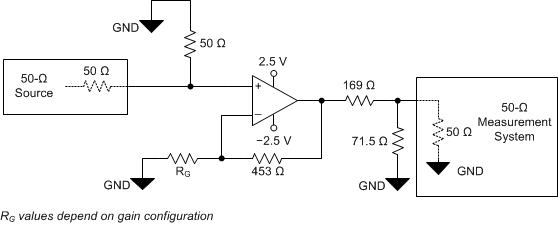JAJSFS3C July 2018 – January 2023 OPA855
PRODUCTION DATA
- 1 特長
- 2 アプリケーション
- 3 概要
- 4 Revision History
- 5 Device Comparison Table
- 6 Pin Configuration and Functions
- 7 Specifications
- 8 Parameter Measurement Information
- 9 Detailed Description
- 10Application, Implementation, and Layout
- 11Device and Documentation Support
- 12Mechanical, Packaging, and Orderable Information
パッケージ・オプション
メカニカル・データ(パッケージ|ピン)
- DSG|8
サーマルパッド・メカニカル・データ
- DSG|8
発注情報
8 Parameter Measurement Information
The various test setup configurations for the OPA855 are shown in #X2027, #X3481, and #X869. When configuring the OPA855 in a gain of +39.2 V/V, feedback resistor RF was set to 953 Ω.
GUID-05A96AE8-5350-4F4D-9B99-B2D25778B3DF.html#X6877 shows 5-dB of peaking with the amplifier in an inverting configuration of –7 V/V with the amplifier configured as shown in #X3481. The 50-Ω matched termination of this circuit configuration results in the amplifier being configured in a noise gain of 5.3 V/V, which is lower than the recommended +7 V/V.
 Figure 8-1 Noninverting Configuration
Figure 8-1 Noninverting Configuration Figure 8-2 Inverting Configuration (Gain = –7 V/V)
Figure 8-2 Inverting Configuration (Gain = –7 V/V) Figure 8-3 Capacitive Load Driver Configuration
Figure 8-3 Capacitive Load Driver Configuration